Flexural Performance of a Continuous Circular Tube Girder Bridge
Abstract
:1. Introduction
2. Experimental Program
2.1. Experiment Overview
2.2. Experimental Results
3. Finite Element Analysis and Results
4. Parametric Study
5. Conclusions
- Under the service load of 175 kN, all members of the proposed pedestrian bridge exhibited stress within the allowable range of 190 MPa. Consequently, the flexural performance of the negative moment region of the pedestrian bridge is analyzed to be safe;
- At the load of 365 kN, equivalent to 210% of the service load, nonlinear behavior containing tensile yielding occurred at the top of the center section of the circular steel-tube girder. Subsequently, additional nonlinear behavior occurred due to local buckling of the circular steel-tube girder at the load of 500 kN;
- The finite element analysis (FEA) results, compared with experimental findings, demonstrated consistent behavior. The local buckling identified in the experiment occurred at the same load level and position as the FEA. Thus, the FEA model proposed in this study can sufficiently predict the structural deformation and failure mode of the proposed pedestrian bridge;
- The FEA results, considering different filling ratios of concrete, indicated a 66.3% reduction in vertical deflection at both ends of the CFCT-100, a 211% increase in yield load, and a 167% increase in maximum load compared to HCT. These results suggest that filling the negative moment region of the circular steel tube with concrete significantly affects vertical deflection and yield load;
- When the circular steel-tube girder was filled with concrete for more than 60% of the length of the girder, the yield load increased by 201% compared to HCT, and the maximum load improved by 155%. Therefore, in terms of economic aspects and constructability, the results suggest that the structural performance can be improved sufficiently if the optimal filling ratio of concrete is more than 60% of the length of the negative moment region of a circular steel-tube girder.
Author Contributions
Funding
Data Availability Statement
Conflicts of Interest
References
- Ali, S.; Thambiratnam, D.; Liu, X.; Fawzia, S. Performance evaluation of innovative composite pedestrian bridge. Structures 2020, 26, 845–858. [Google Scholar] [CrossRef]
- Mendes, P.J.; Barros, J.A.; Sena-Cruz, J.M.; Taheri, M. Development of a pedestrian bridge with GFRP profiles and fiber reinforced self-compacting concrete deck. Compos. Struct. 2011, 93, 2969–2982. [Google Scholar] [CrossRef]
- Deng, S.; Shao, X.; Yan, B.; Wang, Y.; Li, H. On flexural performance of girder-to-girder wet joint for lightweight steel-UHPC composite bridge. Appl. Sci. 2020, 10, 1335. [Google Scholar] [CrossRef]
- Cho, S.; Kong, C.; Kim, Y.; Chung, W.; Lee, H. Fatigue and fracture performance of a pedestrian bridge with a circular steel tube girder. KSCE J. Civil. Eng. 2021, 25, 3019–3030. [Google Scholar] [CrossRef]
- Liu, B.; Liu, Y.; Jiang, L.; Wang, K. Flexural behavior of concrete-filled rectangular steel tubular composite truss beams in the negative moment region. Eng. Struct. 2020, 216, 110738. [Google Scholar] [CrossRef]
- Joo, H.; Moon, J.; Choi, B.; Lee, H. Evaluation of flexural ductility of negative moment region of I-girder with high strength steel. KSCE J. Civil. Eng. 2010, 30, 513–523. [Google Scholar] [CrossRef]
- Xu, C.; Su, Q.; Wu, C.; Sugiura, K. Experimental study on double composite action in the negative flexural region of two-span continuous composite box girder. J. Construct. Steel Res. 2011, 67, 1636–1648. [Google Scholar] [CrossRef]
- Fan, Z.; Wu, F.; He, L.; He, R.; Zeng, K.; Liu, Z. Experimental Investigation on the Mechanical Performance of Steel-ECC Composite Girders with Corrugated Webs under Negative Moment. Materials 2022, 15, 6539. [Google Scholar] [CrossRef] [PubMed]
- Karalar, M.; Dicleli, M. Low-cycle fatigue in steel H-piles of integral bridges; a comparative study of experimental testing and finite element simulation. Steel Compos. Struct. Int. J. 2020, 34, 35–51. [Google Scholar] [CrossRef]
- AASHTO. LRFD Bridge Design Specifications; American Association of State Highway and Transportation Officials: Washington, DC, USA, 2020. [Google Scholar]
- Korea Road Transportation Association. Korean Highway Bridge Design Code; Korea Road Transportation Association: Seoul, Republic of Korea, 2010. [Google Scholar]
- Ali, S.B.; Kamaris, G.S.; Gkantou, M. Flexural behaviour of concrete-filled double skin aluminium alloy tubes. Eng. Struct. 2022, 272, 114972. [Google Scholar] [CrossRef]
- He, A.; Liang, Y.; Zhao, O. Flexural buckling behaviour and resistances of circular high strength concrete-filled stainless steel tube columns. Eng. Struct. 2020, 219, 110893. [Google Scholar] [CrossRef]
- Lu, H.; Han, L.H.; Zhao, X.L. Analytical behavior of circular concrete-filled thin-walled steel tubes subjected to bending. Thin-Walled Struct. 2009, 47, 346–358. [Google Scholar] [CrossRef]
- Tang, X.; Feng, C.; Chang, J.; Ma, J.; Hu, X. Research on the Flexural Performance of Steel Pipe Steel Slag Powder Ultra-High-Performance Concrete Components. Materials 2023, 16, 5960. [Google Scholar] [CrossRef] [PubMed]
- Federal Highway Administration (FHWA). Recording and Coding Guide for the Structure Inventory and Appraisal of the Nation’s Bridges; Report No. FHWA-PD-96-001; U.S. Department of Transportation: Washington, DC, USA, 2010.
- JIS G 3444; Carbon Steel Tubes for General Structure. Japanese Standards Association: Tokyo, Japan, 2015.
- ASTM A572/A572M-07; Standard Specification for High-Strength Low-Alloy Columbium-Vanadium Structural Steel. ASTM International: West Conshohocken, PA, USA, 2007.
- ISO 630; Structural Steels—Plates, Wide flats, Bars, Sections and Profiles. International Organization for Standardization: Geneva, Switzerland, 2003.
- ABAQUS. ABAQUS/Standard User’s Manual; Version 6.21; ABAQUS, Inc.: Pawtucket, RI, USA, 2022. [Google Scholar]
- De Angelis, F.; Taylor, R.L. A nonlinear finite element plasticity formulation without matrix inversions. Finite Elem Anal Des. 2016, 112, 11–25. [Google Scholar] [CrossRef]
- De Angelis, F.; De Angelis, M. On solutions to a FitzHugh–Rinzel type model. Ric. di Mat. 2021, 70, 51–65. [Google Scholar] [CrossRef]
- Ellobody, E.; Young, B. Structural performance of cold-formed high strength stainless steel columns. J. Construct. Steel Res. 2005, 61, 1631–1649. [Google Scholar] [CrossRef]
- Hafezolghorani, M.; Hejazi, F.; Vaghei, R.; Jaafar, M.S.B.; Karimzade, K. Simplified damage plasticity model for concrete. Struct. Eng. Inter. 2017, 27, 68–78. [Google Scholar] [CrossRef]
- Chang, X.; Wei, Y.Y.; Yun, Y.C. Analysis of steel-reinforced concrete-filled-steel tubular (SRCFST) columns under cyclic loading. Constr. Build. Mater. 2012, 28, 88–95. [Google Scholar] [CrossRef]
- Dai, X.; Lam, D. Numerical modelling of the axial compressive behaviour of short concrete-filled elliptical steel columns. J. Construct. Steel Res. 2010, 66, 931–942. [Google Scholar] [CrossRef]
- Chi, Y.; Yu, M.; Huang, L.; Xu, L. Finite element modeling of steel-polypropylene hybrid fiber reinforced concrete using modified concrete damaged plasticity. Eng. Struct. 2017, 148, 23–35. [Google Scholar] [CrossRef]
- Lee, H.; Jung, W.T.; Chung, W. Post-tension near-surface-mounted strengthening systems of full-scale PSC girders. Constr. Build. Mater. 2017, 151, 71–82. [Google Scholar] [CrossRef]
- Tian, Z.; Cai, Y.; Shi, H.; Wang, G.; Zhang, Z.; Dai, Y.; Xu, B. Simulation of Test Arch Based on Concrete Damage Plasticity Model and Damage Evolution Analysis. Appl. Sci. 2023, 13, 11239. [Google Scholar] [CrossRef]
- Lee, H.; Jung, W.T.; Chung, W. Post-tension near-surface mounted strengthening system for reinforced concrete beams with changes in concrete condition. Compos. B Eng. 2019, 161, 514–529. [Google Scholar] [CrossRef]

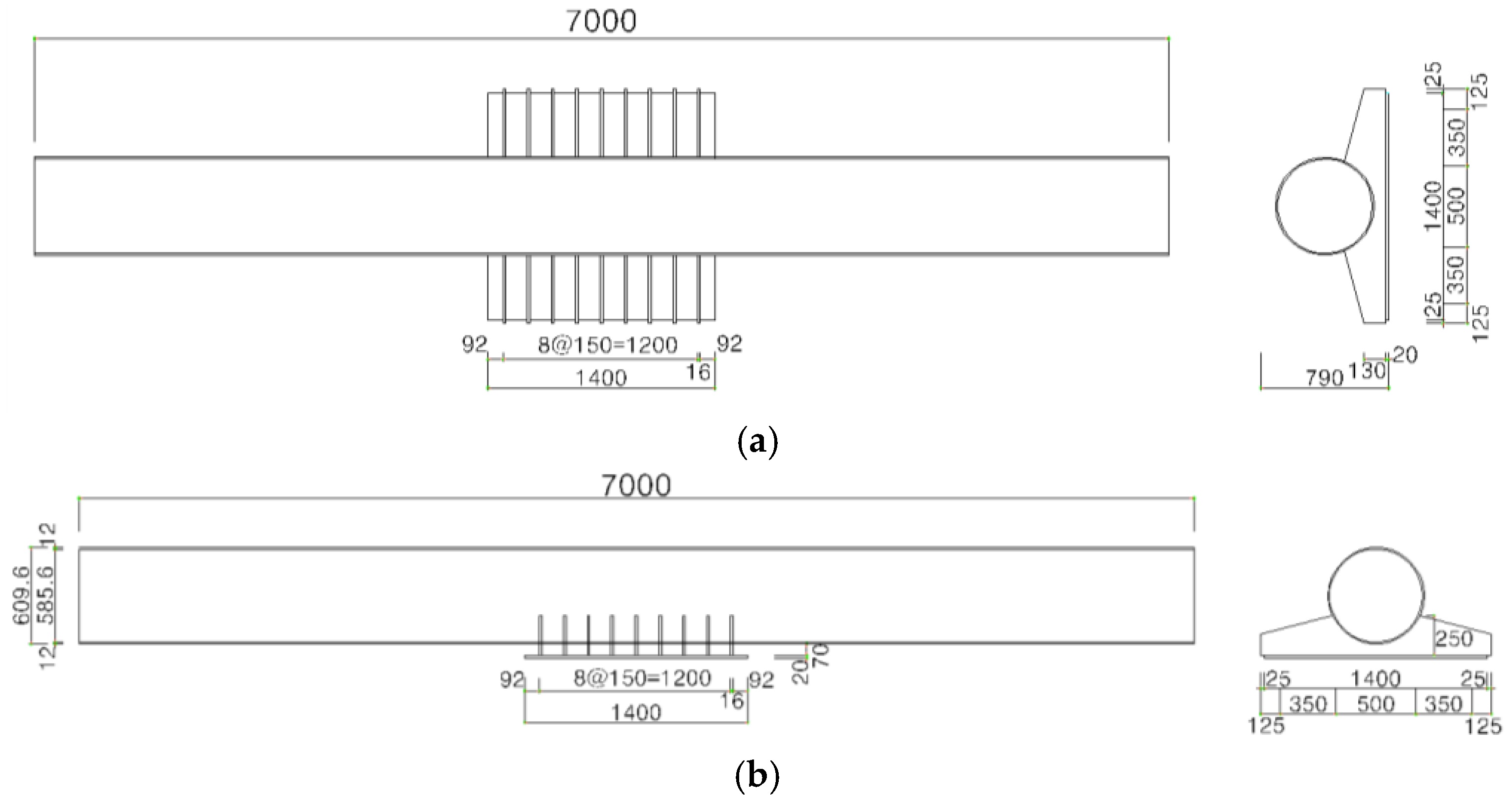
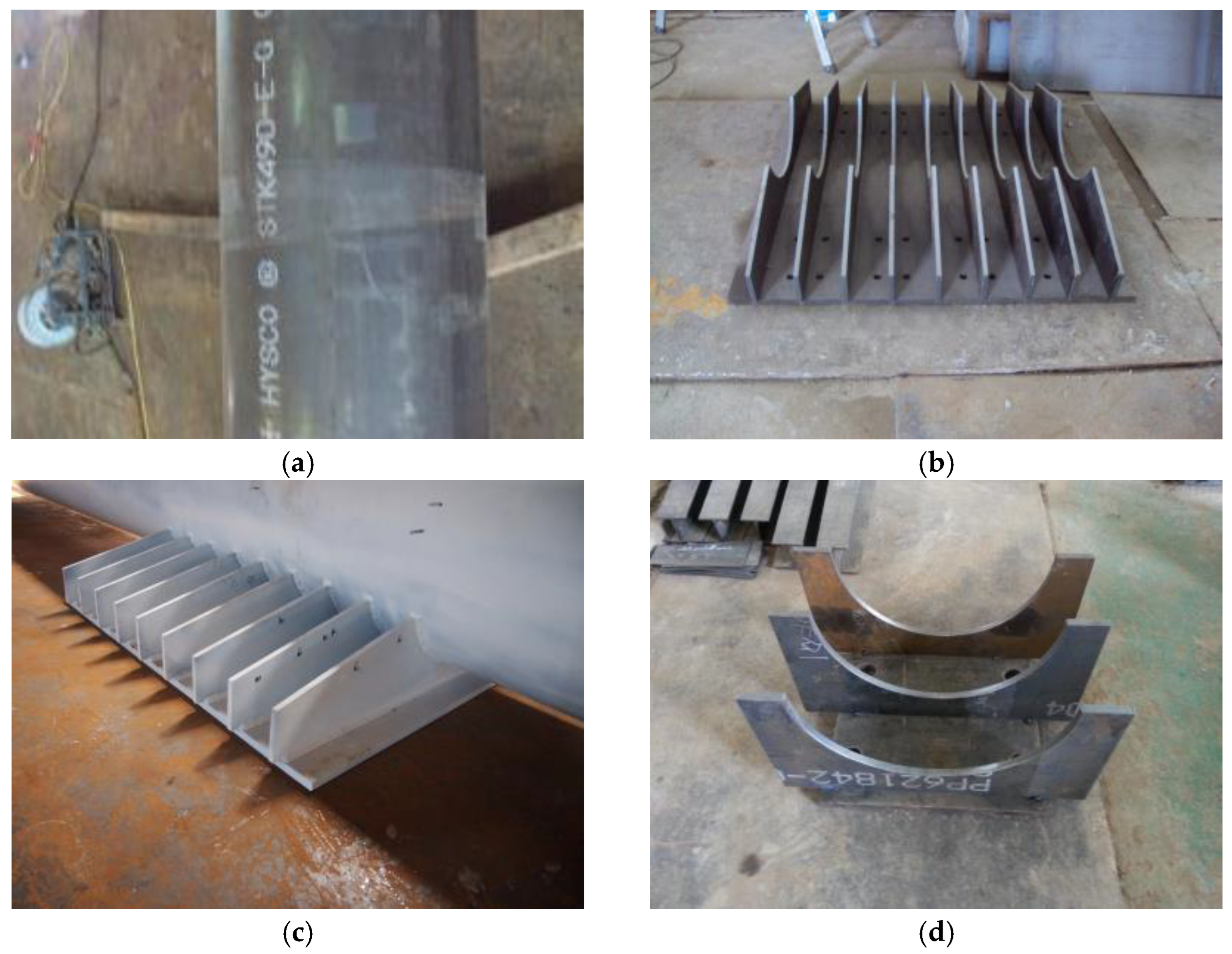
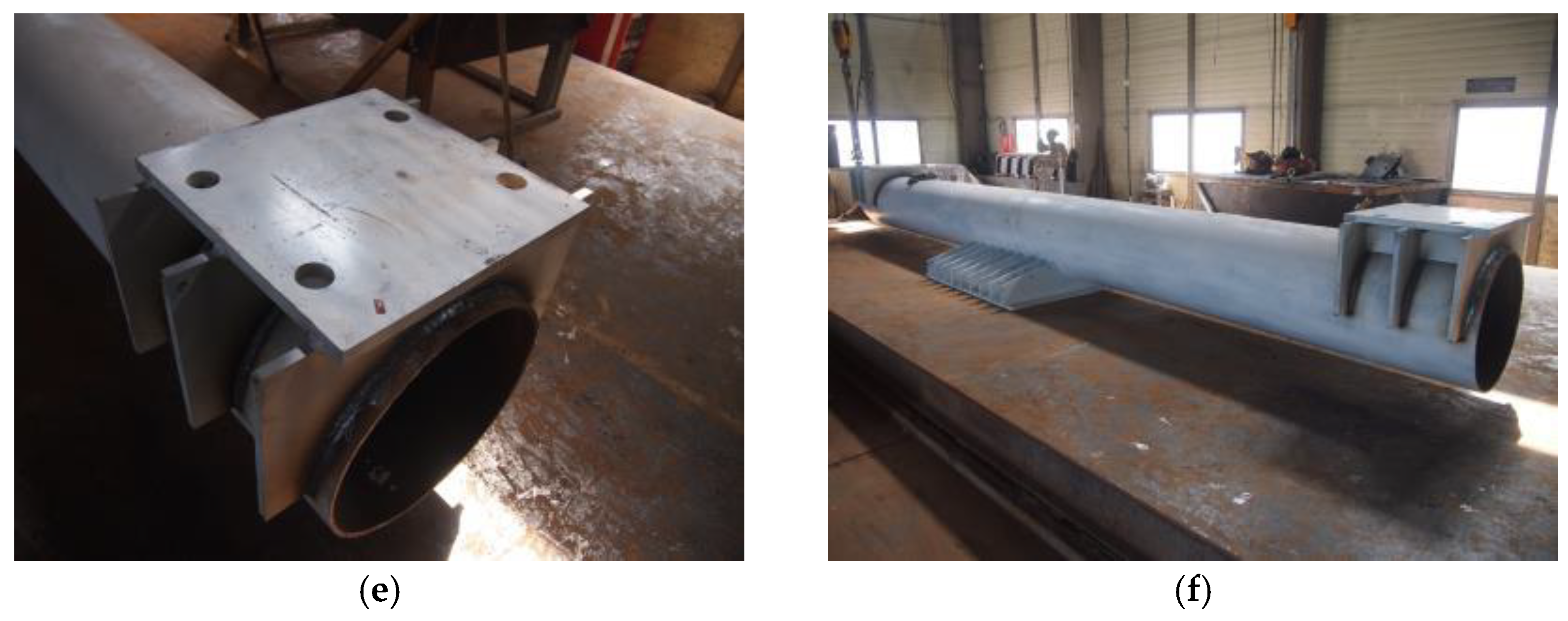


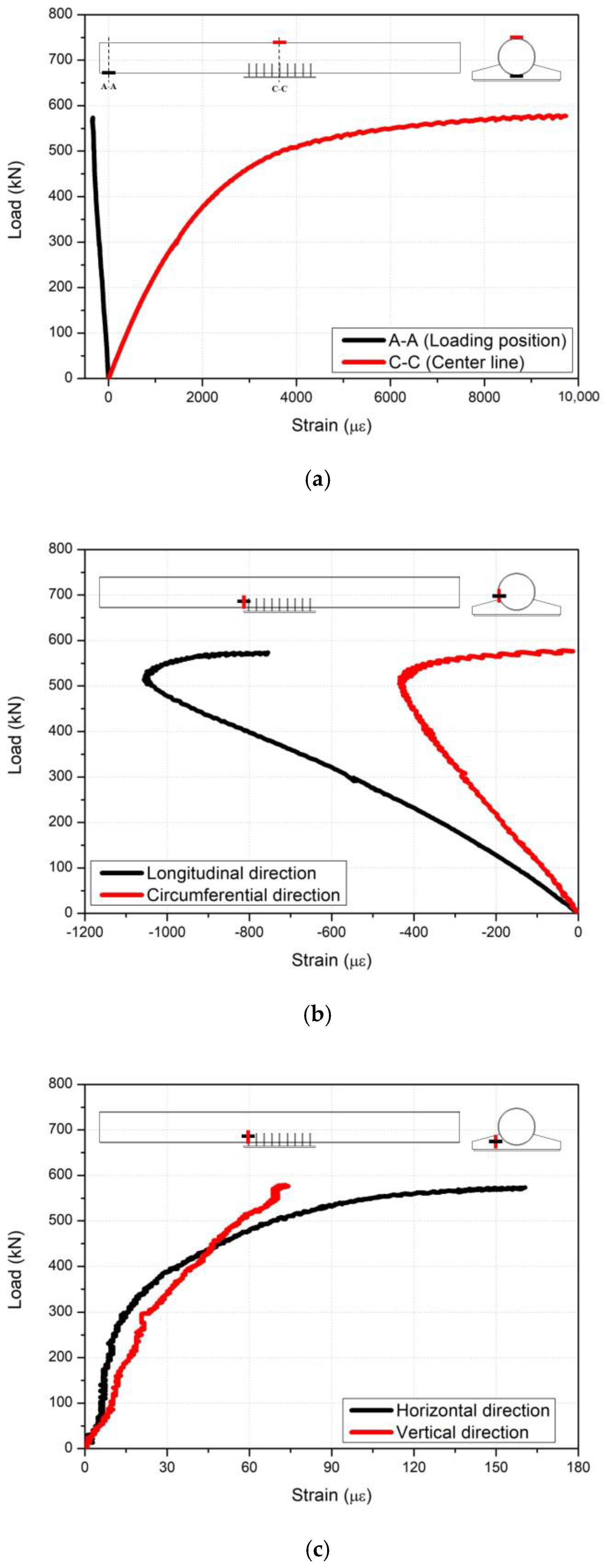

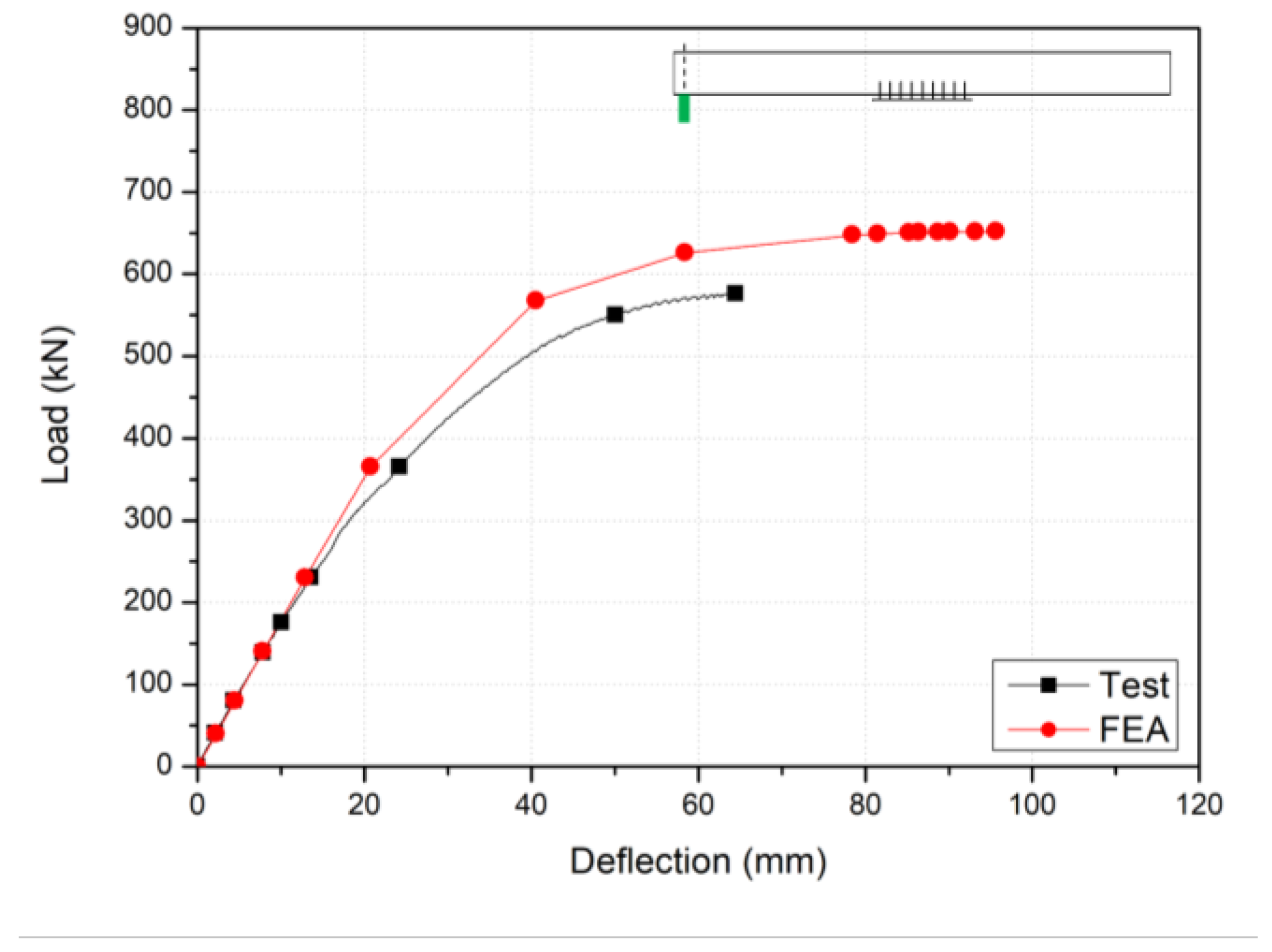

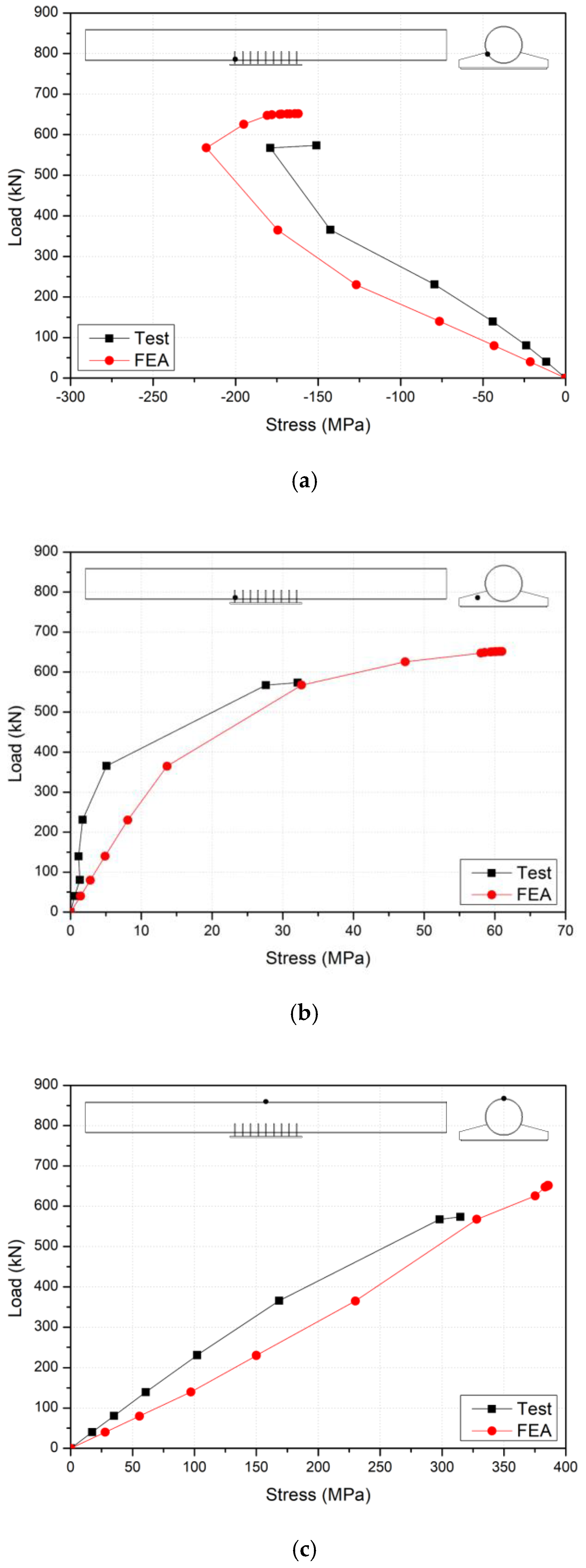


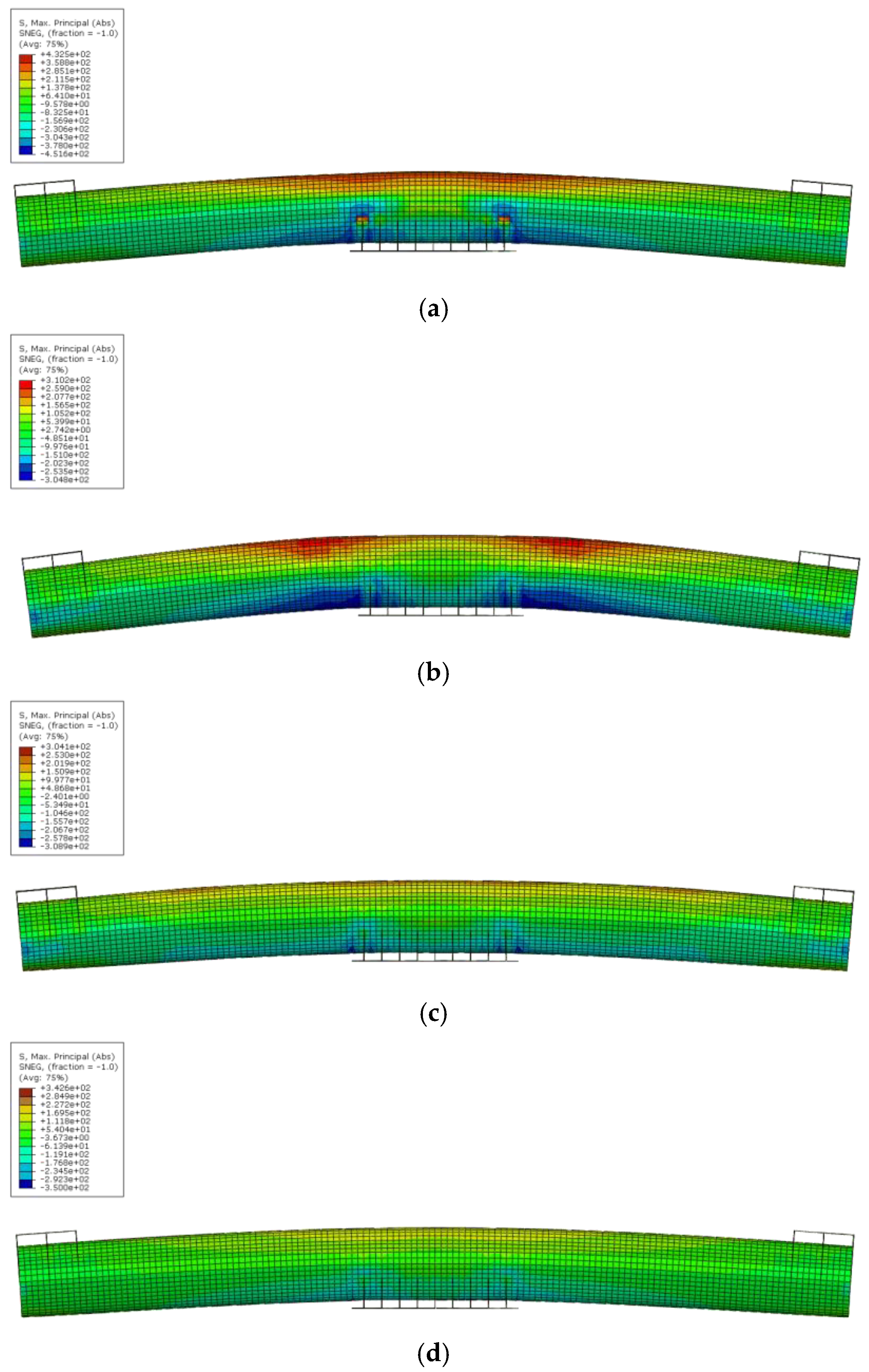
| Load | Member | FEA (MPa) | Test (MPa) | Allowable Stress (MPa) |
|---|---|---|---|---|
| Service load (175 kN) | Circular steel-tube girder adjacent to the vertical steel plates | 98.5 (Compressive) | 57.3 (Compressive) | 190 |
| Vertical steel plate | 6.2 (Tension) | 1.5 (Tension) | ||
| Top of circular steel-tube girder in negative moment region | 121.4 (Tension) | 76.8 (Tension) |
| Specimens | Yield Load (kN) | Maximum Load (kN) | ||
|---|---|---|---|---|
| HCT | 365 | - | 630 | - |
| CFCT-30 | 446 | 1.22 | 744 | 1.18 |
| CFCT-60 | 734 | 2.01 | 979 | 1.55 |
| CFCT-100 | 771 | 2.11 | 1052 | 1.67 |
Disclaimer/Publisher’s Note: The statements, opinions and data contained in all publications are solely those of the individual author(s) and contributor(s) and not of MDPI and/or the editor(s). MDPI and/or the editor(s) disclaim responsibility for any injury to people or property resulting from any ideas, methods, instructions or products referred to in the content. |
© 2024 by the authors. Licensee MDPI, Basel, Switzerland. This article is an open access article distributed under the terms and conditions of the Creative Commons Attribution (CC BY) license (https://creativecommons.org/licenses/by/4.0/).
Share and Cite
Yun, H.; Park, C.; Cho, S.; Chung, W. Flexural Performance of a Continuous Circular Tube Girder Bridge. Buildings 2024, 14, 357. https://doi.org/10.3390/buildings14020357
Yun H, Park C, Cho S, Chung W. Flexural Performance of a Continuous Circular Tube Girder Bridge. Buildings. 2024; 14(2):357. https://doi.org/10.3390/buildings14020357
Chicago/Turabian StyleYun, Hyojeong, Chunhong Park, Sanghyeon Cho, and Wonseok Chung. 2024. "Flexural Performance of a Continuous Circular Tube Girder Bridge" Buildings 14, no. 2: 357. https://doi.org/10.3390/buildings14020357
APA StyleYun, H., Park, C., Cho, S., & Chung, W. (2024). Flexural Performance of a Continuous Circular Tube Girder Bridge. Buildings, 14(2), 357. https://doi.org/10.3390/buildings14020357







